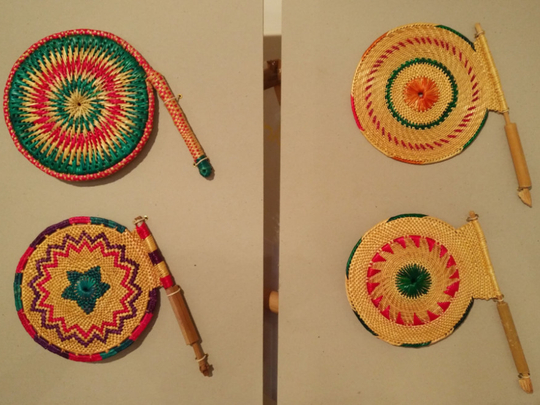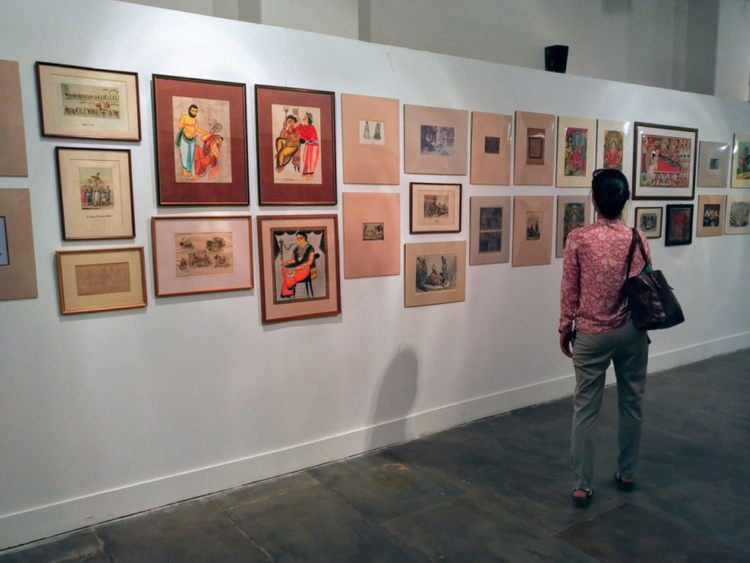
NEW DELHI: The legendary Indian summers are his muse. As soaring temperatures stifle Delhi every year, residents are forced to resort to a variety of means to cool off. From splashing around in pools or lakes, heading to air-conditioned malls to cranking up the AC at home and refusing to step out till the sun sets, many measures are resorted to by residents. But in all these desperate bids, what is missing is a gentle but vivifying habit that once was a staple of summer — fanning oneself.
Called ‘pankhas’ (hand fans), these handy devices were not so long ago a part of every household. And for artist Jatin Das the changing nature of summer habits pushed him into the collectibles territory. Today his collection of ‘pankhas’ is as impressive in its numbers as it is in its variety and beauty.
“I have seen something similar used by a roadside hawker to roast bhuttas [corn],” a child remarked.
The pieces in his collection range in price from between Rs2 to Rs2 million and the majority of the exhibits are from different Indian states.
Other fans in the collection have been sourced from countries as diverse as Japan, Korea, China, Bangladesh, Myanmar, Sri Lanka, Africa, Indonesia and Egypt, all of which Das has travelled to.
Material wealth
The materials from which the fans are fashioned have an equally diverse range, from bamboo, cane, grass, palm leaves, paper and fabric to wood, feather and leather. Many are adorned with beads, mirrors, laces and colourful cloth patchwork.
- Jatin Das | Artist
In different shapes and sizes, the collection includes antique ceiling fans from Mughal and Colonial periods. These were pulled by pankhawallahs who sat outside the room and the fans were used for large congregations in temples, royal courts and offices. Many of the fans are centuries old and priceless.
Rs2m
|
“Many of these were bought by me and some were gifted by friends. I have a fan from Fiji and some leather ceremonial fans of the kings of Africa which former Indian foreign secretary Lalit Mansingh, who was posted in Africa 40 years ago, procured for me on request. No one in the world has these fans. There are also royal fans, which usually consist of a silver handle and zari [pure gold and silver filigree] embroidery,” said Das.
The use of fans as aesthetic props in many dance forms around the world is an integral aspect to these normally utilitarian items. For example, Spanish folding fans are used in modern flamenco dances in southern Spain.
Das has been studying, collecting, researching and documenting arts and crafts from many parts of the world. “The craft of fan-making was always primarily handled by women, as it requires patience for embroidery and sewing work.”
But he rues the fading allure and use of the pankha in modern times. As a result, the making of the various kinds of hand fans is also on the decline.
Fans apart, Das has over 4,000 other collectibles such as paintings and postage stamps released by India’s Department of Posts, graphics and prints on the subject of fans. The collection is so enormous today that it has become difficult for him to preserve it.
The recipient of the Padma Bhushan (2012), one of India’s highest civilian awards, Das, who has been painting for 55 years, complained, “The collection is stored in trunks at a premises for which I pay Rs50,000 rent. I am worried about the upkeep, as the pankhas are fragile and repeated handling, mounting and dismantling at exhibitions in different climatic conditions is making them vulnerable to damage.”
He has sent a proposal to the government with a request to set up a national museum of fans to preserve the traditional craft.
“I am willing to donate my entire collection, which is worth several millions,” he said, adding, “With so many traditional and folk arts vanishing, museums need to be set up by public-private partnerships in order to inculcate a sense of history in our children from a young age.
“Educating and involving them will instill in them the value of our art and heritage,” Das said.
Fan shows
Das has had ‘fan’ shows since 2004. The inaugural show at the National Crafts Museum, Delhi, was followed by exhibitions at the Victoria Memorial (Kolkata), Fan Museum (London), National Art Gallery (Kuala Lumpur), Reitberg Museum (Zurich) and National Museum (Manila).
Until the time a dedicated museum for pankhas is built, his collection will have a permanent place at the upcoming Jatin Das Centre of Art (JDCA), founded by him in Bhubaneswar, Odisha. The art centre aims at preservation and promotion of tribal, folk, classical and contemporary art under one roof.
Das has been collecting fans for the past 40 years. “Initially, I would ask anyone and everyone to bring me varieties of fans. They would laugh at my request as they thought I was joking. But soon they realised I was serious and I ended up recieving many beautiful pieces, some of them hand made by the women in the families.”
As the word spread of his love for the pankha, antique dealers wanting to sell rare heirloom fans of erstwhile havelis began to approach Das.
With a fascination for traditional art forms, not only from India, but from all over the world, Das has amassed an enviable collection of craft items that include textiles, handicrafts, pottery, sculptures, wood carvings, photographs and books.













